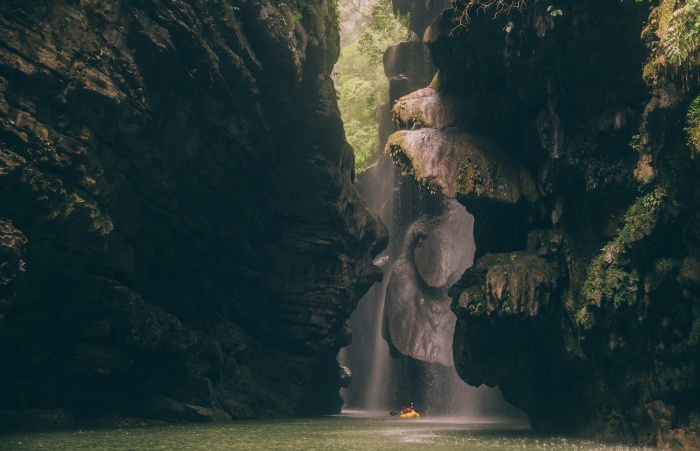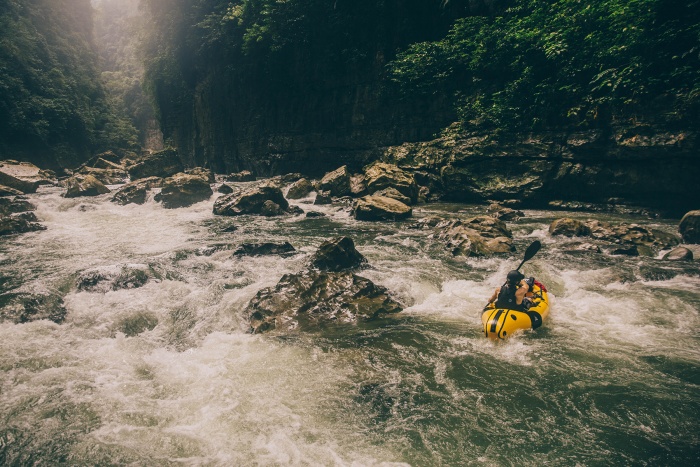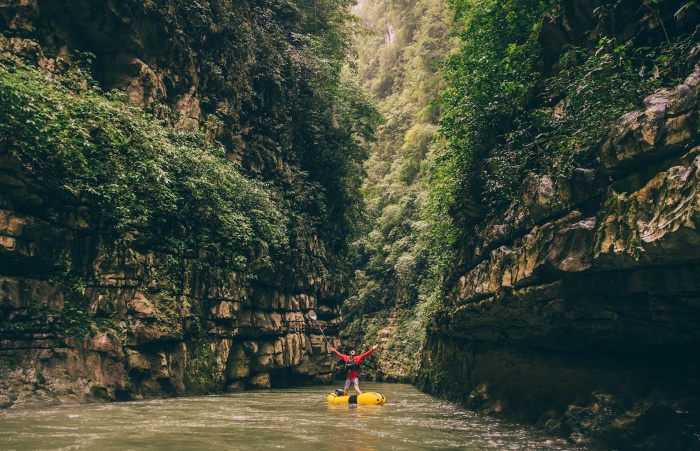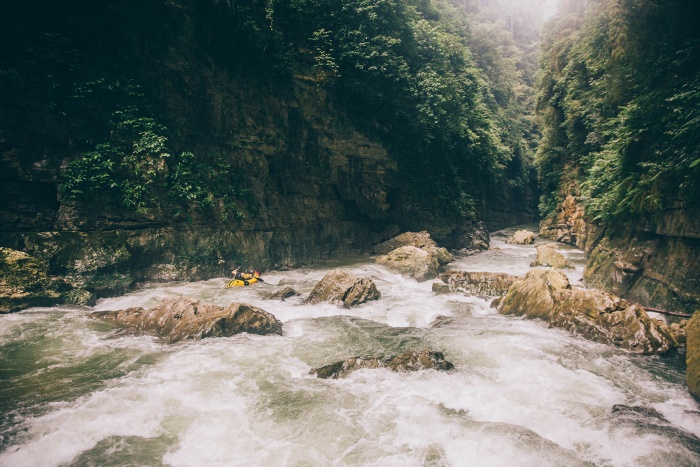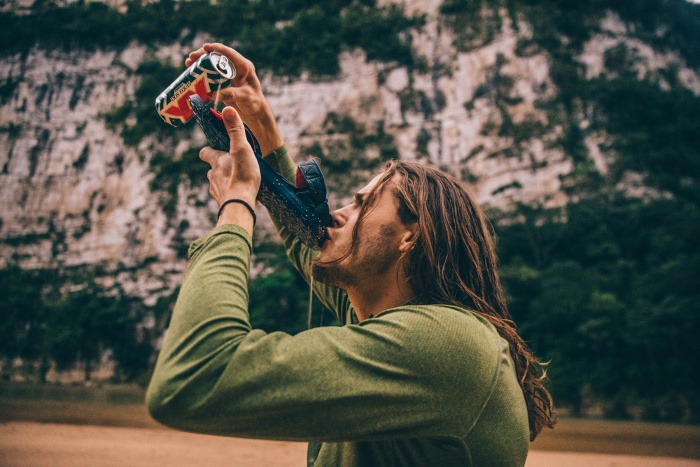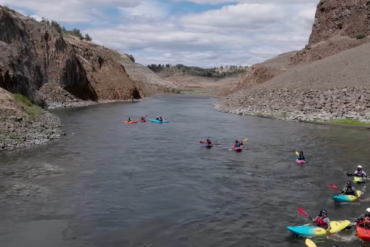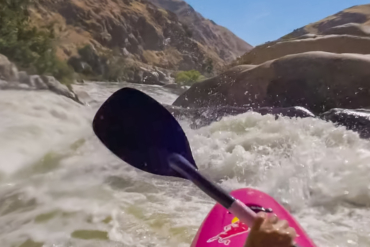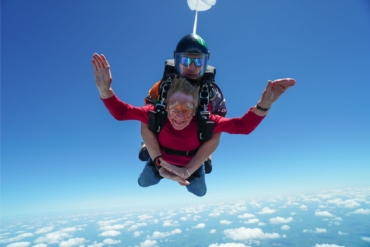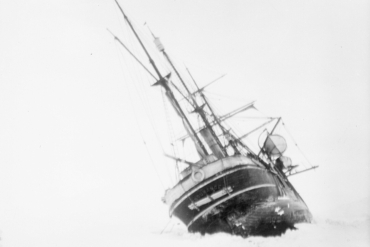You can cram a lot of adventure into very little time. Take, for example, this whirlwind trip to Chiapas, Mexico. We paddled La Venta, a world-class river in a world forgotten by time.
I spent the night on the floor of the Mexico City airport with a lightweight Therm-a-Rest Space Cowboy sleeping bag and Speedvalve mattress – two of the best pieces of gear I own. They work just as well in the backcountry as they do catching a few hours of sleep in a bustling airport.
A missed connection, a date with TSA agents to discuss the purpose of water filters and collapsible paddles, and a glacially slow customs line couldn’t temper my excitement for the next four days.
Over the next 100 hours, Wyatt, my longtime friend and paddling partner, and I would descend the La Venta River. Our route would start just below the Aguacero Waterfall and weave its way to Nezahaulcoyotl Lake, with more than 1,000 feet of drop over the 50-mile descent. This late in the season it is only navigable with packrafts.
I dreamed of paddling La Venta for months and felt lucky to have schedules, weather conditions, and sponsors align.
One Last Gear Check
It was mid-November, near the end of rainy season in Chiapas. Average temps range from the high 70s during the day to low 50s at night.
We packed light to keep us agile, knowing the river was riddled with technical whitewater and portages closer to rock climbing than on-trail hiking. For good measure, Wyatt threw in a couple extra six-packs to make sure we didn’t suffer the entire way.
With a very limited amount of time between touchdown and takeoff, we didn’t have the luxury of causal sightseeing. Wyatt directed the cab driver to the remote river, and we ran through our gear list one last time.
I had my lucky blue Teva sandals, duct tape, and a few extra dry bags – what could go wrong?
Journey to the Sacred Canyon
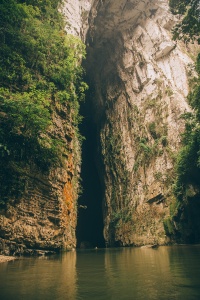
Locals call it the Sacred Canyon. It’s a magical place, in part because it’s still hidden. And, frankly, I feel somewhat conflicted writing this article.
Beyond rough numbers and a few pixelated images from Google Earth, there isn’t much information about the river on the internet.
Our best beta came from a guide who supplied us simple yet sufficient maps and a few hints about navigating the bigger rapids. We weren’t going in completely blind, but it felt like it. Walking into the unknown is increasingly rare these days, and we welcomed it openly.
Arriving at the gated entrance to the waterfall we met a young ranger who informed us of recent landslides. An 8.2-magnitude earthquake in September caused notable wreckage across the area. The guide explained that the river hadn’t been paddled since the quake – and it could be completely changed and possibly dangerous.
We saw our first evidence of this as we hiked down to the water – the entire beach was covered in rocks and debris. Our maps were downgraded to loose guidelines. We had an adventure in front of us.
It was late afternoon by the time our gear was organized, food divided, and Alpacka Gnarwhals rigged. A few hours of paddling and a handful of rapids transported us into a lost world.
Surreal Beauty: Paddling La Venta
For the next three days we didn’t see or hear another soul. Arriving at a sandy beach near dusk, we assembled our Hyperlite Ultamid 2 tent with ease and threw together a quick dinner.
For all international trips, I bring an MSR Dragonfly Stove, which I’ve owned for nearly a decade. It runs on any type of fuel you can find (regular gasoline in this case), and repair is relatively easily. We crashed soon after dinner, worn out from a long, unpredictable day.
Light rain woke us in the morning. We made coffee, shuffled some gear, and pointed our Alpacka Raft Gnarwal packrafts downstream. Wyatt and I have kayaked since we were kids – the act itself feels like an old, familiar friend. Paddling together filled the two of us with youthful energy.
The next couple days seemed to bend space and time. Every corner we rounded opened up a chorus of expletives from both of us. Words and photos don’t do this river justice.
La Venta is unrelenting with surreal beauty and visceral rawness. Massive white walls climb hundreds of feet above the river. Lush green canopies dangle vines down to the water. Rain and mist dance through the valley.
Whitewater sets string one after another, with hours of eddy hopping and wave surfing. Waterfalls seem to pour from the rock itself. Towering caves, clambering monkeys, birds of all colors and sizes – Avatar jokes finally make sense to me.
The crux of the river sits just past halfway – two heinous portages and a must-run class IV called Complicado that more than lives up to its name. Parties must navigate a fast-flowing boulder field laden with nasty holes and strainers. Steep cliff walls on both sides give no other options.
Once through, a narrow and placid stretch of water is a reward. The river grows in volume near the end, with big drops and powerful waves. Looking back, there were probably over 100 unique rapids.
The Long Road Home
It would be easy to spend a week on the La Venta and still beg for more. Yet, as with most trips, we had flights to catch. On our fourth morning we found our way to the river delta and paddled our final 10 kilometers across the lake to a small, boat-access-only town.
A few hours drying out gear, a ferry across the rest of the lake, a taxi to the town center, a bus back to Tuxtla, and a taxi to the hotel consumed the rest of the day.
We feasted on street tacos and found WiFi to let our friends and family know we were safe. At that point, it didn’t seem real. It still doesn’t. We’re lucky to have found such a hidden gem.
My advice for all searching for solitude and comfortable paddling class III+ water: Go now, and paddle with care and respect.

